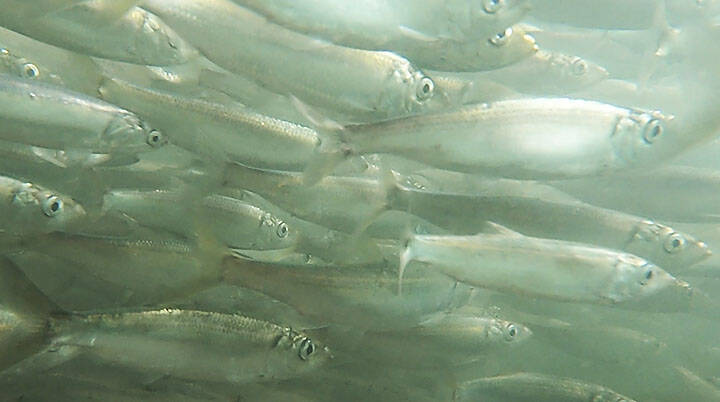Spring may have melted away dreams of snow, but the beaches of Bainbridge Island are still dappled with pearly white specks — herring season is upon us, and if recent trends continue, it’s going to be a party.
For a few days in March and April, the shores along the north and eastern side of BI turn a beautiful cerulean and turquoise with herring spawn. Marine animals by the thousands from all walks (and currents) of life descend on the scene to feed. It’s a spectacle, local scientists agree, but one that deserves the hype. Pacific herring spawn are the bedrock of the aquatic ecosystem in Puget Sound — fueling salmon, orcas, sea lions, porpoises, sharks, gulls, otters, eagles, ducks and all manner of predatory fish — and only five years ago, they were almost extinct.
Brian Whitlock of Bainbridge has become something of a herring herald. His backyard view is uniquely situated to watch the annual event, and marine scientists around the peninsula rely on his photography to keep tabs on the herring.
“You know this is happening because the wildlife comes out in full force,” Whitlock said. “It’s special because it’s right here. We’re fairly suburban on Bainbridge, and in other places, you have to travel miles to see wildlife like this. But this is right in our backyard.”
This March marks the fourth year since the Pacific herring around BI made a miraculous comeback in 2020.
Jon Oleyar, fisheries biologist for the Suquamish Tribe, recalled days spent surveying herring eggs in the 1990s from a small boat. There were some eggs, but not a lot, he said. Alternating boom-and-bust years are normal for herring, some researchers say, but returns around Madison Bay were consistently low. As time went on, the population crashed throughout Puget Sound.
By 2019, the state Department of Fish and Wildlife began to consider labeling the Pacific herring extinct. But in 2020, there was a sudden change — there were more than ever. “It went from almost nothing, to ‘Holy cow, where did these fish come from?’” Oleyar said.
He watched with some tribal elders in downtown Suquamish, and the group was in awe. “The [elders] didn’t recall seeing anything like that, even going back to their grandparents’ time, 50 to 100 years ago. That was probably one of the bigger spawn events locally that some of these tribal members have seen in their lifetime.”
Since then, spawning events around BI have held steady, Oleyar said. But the reason for the comeback is not clear. Research shows that herring numbers tend to be all over the place. Additionally, the herring’s preferred habitat shifted and declined rapidly for years, leaving nothing for the fish to spawn on. But their powerful comeback, combined with improvements to nearshore habitat by environmental groups, leads Oleyar to speculate that the herring “may have always been around, just in a different location. I like to think that it’s because the oceans are not as bad as we think,” he said.
Pacific herring season is nature’s continental breakfast after the long dark winter. The eggs look like strings of gummy pearls attached to algae and other aquatic foliage, like seaweed and eelgrass, and can be seen clinging to marine vegetation that washes up onshore.
Right now, most of the herring around BI are shoaling, or gathering in large numbers in preparation to spawn, said Anne Shaffer, lead scientist at the Coastal Watershed Institute and affiliate professor with Western Washington University College of the Environment. Actual spawning involves the male fish broadcasting milt, or sperm, into the water and females “furiously laying eggs” on available habitat, she explained, which causes the brightly colored water near shore. “It’s well documented that herring can be very discriminating about their spawning location and can hold off for weeks, [but] once they start, it is full-on,” Shaffer said.
Telltale signs of a herring spawn event are hard to miss, Whitlock said. The water will “look like the Caribbean,” for one, but there will also be large numbers of animals, like sea lions and eagles — all of which will be celebrating quite loudly.
It may look like fun, but Oleyar cautions beachgoers to step carefully during spawning. The eggs are sensitive to vibrations, chemicals and other disturbances and are best enjoyed from a distance, he said.
The fish may spawn repeatedly during a season, Shaffer added, but what compels them to do so is still a mystery. Some speculate that the events are tied to the cycles of the moon, but it’s not conclusive. “What triggers [spawning] is a complex set of environmental cues that we don’t fully understand,” she said.
Plenty of animals are happy to feast on herring roe, but when the eggs hatch after about two weeks, the action ticks up a notch. “The hatched larvae fill, and fuel the Salish Sea, heralding the first plankton bloom of the year. Salmon juveniles are at the same time arriving along the shoreline and will soon depend on these herring for food as they grow,” Shaffer said. “[Transient] orcas will soon appear to predate on the sea lions and Resident [orcas] on the salmon feeding on the herring.”



